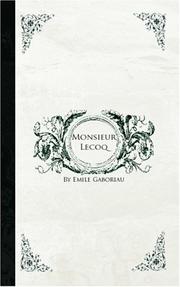Émile Gaboriau facts for kids
Quick facts for kids
Émile Gaboriau
|
|
|---|---|
 |
|
| Born | 9 November 1832 Saujon, France |
| Died | 28 September 1873 (aged 36) Paris, France |
| Genre | Detective fiction |
| Notable works | Monsieur Lecoq (1868) |
Émile Gaboriau (born November 9, 1832 – died September 28, 1873) was a French writer. He was a very important person in starting a popular type of story called detective fiction. He wrote many novels and worked as a journalist.
Contents
Early Life of Émile Gaboriau
Émile Gaboriau was born in a small town named Saujon in France. His father, Charles Gabriel Gaboriau, worked for the government. His mother was Marguerite Stéphanie Gaboriau.
Before becoming a famous writer, Gaboriau worked as a secretary for another writer, Paul Féval. He wrote some novels and other pieces. But he truly found his talent when he wrote L'Affaire Lerouge in 1866.
Creating Detective Stories
Gaboriau's novel L'Affaire Lerouge is often seen as the very first detective story in France. It tells a mystery by looking back at past events. This helps to solve what is happening in the present.
Monsieur Lecoq: A New Kind of Detective
This book introduced two new characters. One was an amateur detective, meaning he wasn't a professional police officer. The other was a young police officer named Monsieur Lecoq. Lecoq became the main hero in three more of Gaboriau's detective novels.
The character of Lecoq was inspired by a real person. This person was Eugène François Vidocq (1775–1857). Vidocq was a thief who later became a police officer. His own life story, Les Vrais Mémoires de Vidocq, mixed true events with made-up ones.
Gaboriau might also have been influenced by a villain named Monsieur Lecoq. This character was in a book series called Les Habits Noirs by Paul Féval.
Science and Solving Crimes
Gaboriau's stories also showed a new way of solving crimes. He was likely influenced by a way of thinking called positivism. This idea, promoted by Auguste Comte, suggested that science could answer all questions.
Because of this, Gaboriau's detectives used new scientific methods. They didn't just question people or rely on eyewitnesses. They used science to find clues and catch criminals.
Fame and Future of Detective Fiction
L'Affaire Lerouge was first published in a newspaper called Le Soleil. It quickly made Gaboriau famous. The story was about a quiet woman who was murdered because of a secret. This mystery gained Gaboriau many fans.
However, when Arthur Conan Doyle created Sherlock Holmes, Monsieur Lecoq's fame around the world started to fade. L'Affaire Lerouge was even made into a play in 1872. Gaboriau wrote many more popular novels about police cases. He passed away in Paris from a lung problem.
His books were generally well-liked. For example, Harper's magazine wrote in 1872 that The Mystery of the Orcival was a "remarkable and unique" detective story.
Interestingly, in A Study in Scarlet, Arthur Conan Doyle's character Watson asks Sherlock Holmes what he thinks of Gaboriau's work. Holmes calls Lecoq "a miserable bungler."
Émile Gaboriau's Books
Gaboriau wrote many books, including series and stand-alone novels.
Book Series
Mariages d'aventure
- Monsieur J.-D. de Saint-Roch, ambassadeur matrimonial (1862) – Also known as The Matrimonial Ambassador: Monsieur J. D. de Saint-Roch
- Promesses de mariage (1862) – Also known as Promises of Marriage
Lecoq and Other Stories
- L'Affaire Lerouge (1866) – Also known as The Widow Lerouge or The Lerouge Affair
- Le Crime d'Orcival (1867) – Also known as The Mystery of Orcival
- Le Dossier n° 113 (1867) – Also known as Dossier No. 113, File No. 113, or The Blackmailers
- Les Esclaves de Paris (1868) – This book has two parts: Le Chantage (Caught in the Net) and Le Secret de la Maison de Champdoce (The Champdoce Mystery)
- Monsieur Lecoq (1869) – This book also has two parts: L'Enquête (The Inquiry or The Detective's Dilemma) and L'Honneur du nom (The Honor of the Name or The Detective's Triumph)
- La Vie infernale (1870) – This book has two parts: Pascal et Marguerite (The Count's Millions) and Lia d'Argeles (Baron Trigault's Vengeance)
- La Clique dorée (1871) – Also known as The Clique of Gold or The Gilded Clique
- La Dégringolade (1872) – Also known as Catastrophe or The Downward Path
- La Corde au cou (1873) – Also known as Rope Around His Neck, In Peril of His Life, or In Deadly Peril
- L'Argent des autres (1874) – Also known as Other People's Money or A Great Robbery
- Une Disparition (1876) – Also known as A Disappearance, Missing!, or 1000 Francs Reward
Other Novels
- Le treizième Hussards (1861) – The 13th Hussars
- Les Gens de Bureau (1862) – The Men of the Bureau
- Le Petit Vieux des Batignolles (1876) – The Little Old Man of Batignolles
- Maudite maison (1876) – The Unfortunate House
- Casta vixit (1876) – Love, the Conqueror
Films Based on Gaboriau's Work
Many of Émile Gaboriau's novels have been made into films and TV shows.
- Monsieur Lecoq (1914), directed by Maurice Tourneur.
- L'Affaire d'Orcival (1914), directed by Gérard Bourgeois.
- Monsieur Lecoq (1915), with William Morris as Lecoq.
- The Family Stain (1915), directed by Will S. Davis.
- The Evil Women Do (1916), directed by Rupert Julian.
- Thou Shalt Not Steal (1917), directed by William Nigh.
- File 113 (1933), directed by Chester M. Franklin, with Lew Cody as Lecoq.
- Monsieur Lecoq (TV series, 1964–65), with Léo Ilial as Lecoq.
- Nina Gipsy (TV film, 1971), directed by Claude-Jean Bonnardot, with Henri Lambert as Lecoq.
- Der Strick um den Hals (TV miniseries, 1975), directed by Wilhelm Semmelroth.
- Die Affäre Lerouge (TV film, 1976), directed by Wilhelm Semmelroth.
- La Corde au cou (TV miniseries, 1978), directed by Marcel Moussy.
Images for kids
See also
 In Spanish: Émile Gaboriau para niños
In Spanish: Émile Gaboriau para niños


